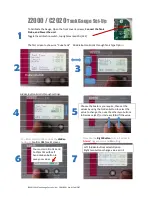
Side 6 of 16
Userguide CableTroll 210 March 2020
01021000/11/12/13
3. Functional description
3.1 Fault currents in cable network
The short circuit current magnitude is mainly given by voltage level, type of transformer, primary feeding
network and the distance from the feeding transformer to the fault location.
A cable short circuit will normally cause a fault current in the kA-range. When short circuit appears near
the end of a long line, the fault current is most likely to be of a significantly lesser value.
In networks with directly earthed neutral an earth fault is equivalent to a phase-to-earth short circuit.
The current magnitude will in this case be almost equal to the fault current of a phase-to-phase short
circuit.
For networks that do not have a directly earthed neutral, the magnitude of the singular earth fault
current is determined by the size of the galvanically interconnected network, the voltage level, type of
cable and the neutral equipment.
The magnitude of a fault current during a dual earth fault will be almost equal to a short circuit in
networks that do not have a directly earthed neutral.
IMPORTANT:
As the sensor principle is of the threshold type, correct use of the indicator is subject to calculations of
earth fault currents and capacitive discharge currents through the sensor element (seen from the
feeder).
The capacitive discharge current from behind the Rogowski coil/CT/earth fault element must not exceed
the trip level setting of the indicator.
The capacitive discharge current will vary between the different types of cable, and the cable supplier
should be consulted about the data for your specific type in order to make the correct calculations.
In compensated networks, the earth fault detection may not be possible in certain locations depending
on the degree of compensation.
3.2 Capacitive Discharge Currents
The CableTroll 210 series indicators is not directional, (see CableTroll 3500 for directional) it therefore
detects current without discriminating its direction. In case of an earth fault, the network capacitive
energy discharges in the fault point.
It should be checked that the capacitive discharge current downstream the indicator is below pre-set trip
level in order to avoid the indicator erroneously activating upon earth faults. If the total capacitive
current exceeds the trip level, it is advisable to change the trip level or install the indicators in the
branching points instead of in the main line.
The capacitive discharge of a branching point is limited by its own capacitance, while in the main line
the capacitive current of all the branches downstream the indicator is added.
Underground cables have larger capacitance than overhead lines. This must be considered when an
overhead line feeds an underground cable and vice versa.


































